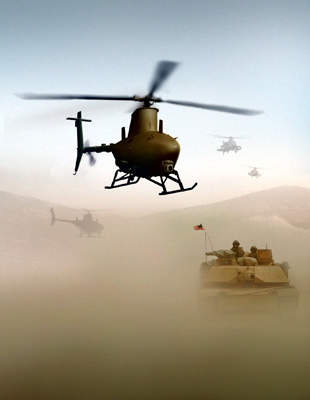The MQ-8B Class IV UAV, developed by Northrop Grumman, is based on the highly successful RQ-8A vertical take-off and landing tactical unmanned aerial vehicle (VTUAV) system developed for the US Navy, that had successfully completed over 245 test flights since May 2002.
The US Army selected the MQ-8B in August 2003 for the US Army’s class IV UAV, which is part of the US Army’s future combat systems (FCS) programme. The system provides the Army with real-time imagery, data collection and dissemination at brigade level.
MQ-8B Fire Scout unmanned helicopter development
The MQ-8B was also ordered by the US Navy in 2005 and 2007. The Army and Navy are exercising a joint acquisition strategy of the MQ-8B to maximise commonality between the two services.
The US Army SDD (system development and demonstration) contract for the production of seven air vehicles was awarded in January 2004. First flight of the MQ-8B for the US Navy was in December 2006, at Patuxent River Naval Air Station. MQ-8B entered low-rate initial production (LRIP) in May 2007. First flight for the US Army variant was in February 2011.
The air vehicle has an endurance of more than seven hours, meaning that the Army’s FCS class IV unmanned air vehicle system, consisting of four Fire Scout air vehicles, has the capacity for continuous operation. The on-board sensor suite and laser rangefinder and designator allow the Fire Scout to quickly and accurately detect, locate, identify, track and designate targets and carry out battle damage assessment.
Fire Scout unmanned air vehicle design
The Fire Scout design work is carried out at Northrop Grumman’s Unmanned Systems Development Center in San Diego. The assembly is carried out at the Northrop Grumman Center at Moss Point in Mississippi.
The air vehicle airframe is supplied by Schweizer and is based on the Schweizer 333 manned helicopter modified with an aerodynamically streamlined fuselage. The rotor blade diameter is 8.4m and the rotor blades are folded for storage and transportation. The vehicle length with folded rotors is 7m.
The air vehicle is powered by a Rolls-Royce Model 250-C20W engine, developing 313kW.
Payload
Modular mission packages include an electro-optical infrared (EO-IR) sensor, a tactical synthetic aperture radar / moving target indicator (TSAR / MTI), a communications relay package, a training sensor, mine, chemical and radiological detection and an RF emissions locator.
The US Army Fire Scout is also equipped with the Northrop Grumman airborne surveillance and target acquisition minefield detection system (ASTAMIDS). The ASTAMIDS applications include day and night reconnaissance, surveillance and target acquisition (RSTA), in addition to minefield detection.
ASTAMIDS carries multi-sensor electro-optical infrared and multi-spectral imaging systems to detect patterned surface emplaced mines, patterned recently buried mines, and randomly scattered mines.
The sensors detect obstacles, combat vehicles, combat targets and camouflaged targets. ASTAMIDS uses quad-prism aperture splitters, an illuminator and target designator and rangefinder. ASTAMIDS was first test-flown onboard a company-owned MQ-8B in September 2008.
The Fire Scout with joint tactical radio systems (TRS) and the US Army’s warfighter information network-tactical (WIN-T) telecommunications system components can operate as a communications node.
Fire Scout weapons
Smart bombs, missiles or projectile weapons are possible candidates for the Fire Scout.
The MQ-8B will be capable of deploying Hellfire laser-guided missiles or two packs of four 70mm (2.75in) Hydra rockets or advanced precision kill weapon system laser-guided rockets or two Northrop Grumman Viper Strike precision munitions. Viper Strike has global positioning system (GPS) guidance and a semi-active laser seeker.
Performance
The MQ-8B Fire Scout has a significantly increased capability compared to the first generation RQ-8A. A fourth rotor blade has been added.
Fire Scout will be capable of deploying Hellfire laser-guided missiles."
The added rotor blade and other enhancements, including an upgraded gearbox, provide a greater payload capacity up to 272kg (600lb). The MQ-8B fuselage is fitted with side-mounted sponsons for carrying pods or weapons.
The MQ-8B has a larger fuel capacity than the RQ-8A and carrying a standard payload can stay on station for up to six hours at a distance of 110 miles from launch.
Launch and recovery
The air vehicle is fitted with 1.75m skids. Fire Scout uses a conventional autonomous launch and recovery and can operate from unprepared sites close to battlefield command posts and operations centres.




